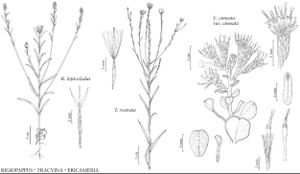Tracyina
Madroño 4: 74, fig. 1. 1937.
| Taxon | Illustrator ⠉ | |
|---|---|---|
 | Rigiopappus leptocladus Tracyina rostrata Ericameria cuneata var. cuneata | Yevonn Wilson-Ramsey Yevonn Wilson-Ramsey John Myers |
Annuals, 5–30+ cm (taprooted). Stems erect, simple or branched distally, glabrous or sparsely hirsutulous. Leaves mostly cauline (at flowering); alternate; ± sessile; blades (1-nerved or 3-nerved), lance-linear to linear, margins entire (ciliate), faces glabrous or sparsely hirsutulous. Heads radiate, borne singly (tips of branches). Involucres ± cylindric to turbinate or obconic, 1–3+ mm diam. Phyllaries (persistent) (6–) 20–30+ in (2–) 3–4+ series, appressed, 1-nerved (flat),linear to subulate, unequal (outer shorter), herbaceous, abaxial faces glabrous or sparsely hirsutulous. Receptacles convex, pitted or smooth, epaleate. Ray-florets (3–) 12–15 (–20+), pistillate, fertile; corollas yellowish, often tinged with purple (laminae inconspicuous). Disc-florets (4–) 15–25+, bisexual, fertile; corollas pale-yellow to purplish, tubes shorter than narrowly cylindric throats, lobes 5, erect, lance-deltate; style-branch appendages attenuate. Cypselae ± fusiform (distally attenuate, almost beaked), 5-nerved, glabrous or glabrate (ray) or ± hirsutulous (disc); pappi persistent (fragile), of (12–) 30–40 whitish, barbellulate, apically attenuate bristles in 1 (–2) series (subequal or outer shorter). x = 9.
Discussion
Species 1.
Selected References
None.